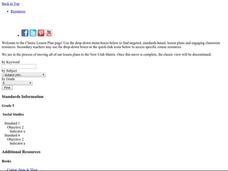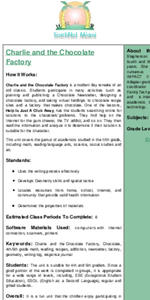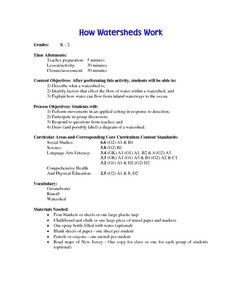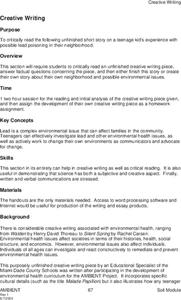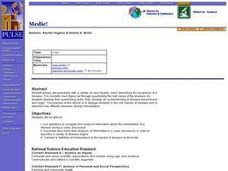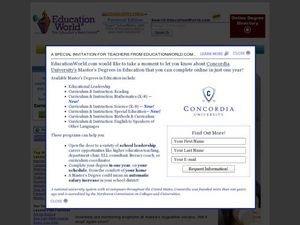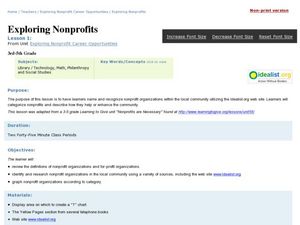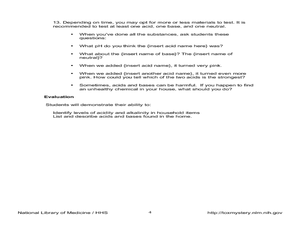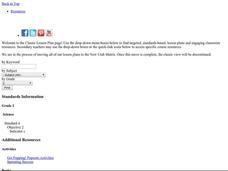Curated OER
King Cotton
Fifth graders explore the cotton plant. In this cotton lesson, 5th graders research the process of growing cotton. Students explore the economic and cultural differences in the states that grew cotton for trade and industry.
Curated OER
From Foraging to Farming
Students experience the difficulty that goes along with foraging for food. In this lesson on the importance of modern agriculture, students simulate how there simply is not enough food and water for everyone when agricultural means are...
Curated OER
Risk Taking Behaviors
Tenth graders listen to a presenters introduction and write questions they hope to have answered during the presentation. They listen to a presentation and record notes. They participate in small group discussion and complete...
Curated OER
Charlie and the Chocolate Factory
Fifth graders participate in a variety of math and language arts activities based on chocolate.
Curated OER
What's in a Willow?
Students study of nutritional value of edible native plants. discriminate between foods that have nutritional value and those that do not. They relate how food can affect how they think, feel, and perform.
Curated OER
How Wathersheds Work
Students describe a watershed. They identify factors that effect the flow of water within a watershed. They explain how water can flow from inland waterways to the ocean.
Curated OER
Creative Writing
Students criticially read an unfinished creative writing piece, answer factual questions concerning the piece, and then finish the story or create their own story about their own neigborhood and possible environmental issues.
Curated OER
Radioactive Isotopes
Students describe an isotope and radioactive isotope in a written essay. They describe how a specific country or region was affected by radioactive contamination and attempt to sympathize with those affected by these radioactive...
Curated OER
The Dangers of Illiteracy
Students consider a fictional situation in which literacy could spell the difference between life and death. They apply their knowledge of how reading empowers people by creating a literacy program that addresses the special needs of a...
Curated OER
Medic!
Students navigate and analyze information about the presentation of a disease during a class discussion. They document and share their analysis of information in a class discussion in order to describe a variety of disease origins.
Curated OER
Wind Provides Electricity for Homes, Schools
Students complete a KWL chart, then read a news article about the comeback of windmills. In this current events lesson, the teacher introduces the article with a KWL chart and vocabulary activity, then students read the news report and...
Curated OER
Scientists Use Web Site to Report Volcano Activity
Students react to statements about volcanoes, then read a news article about scientists monitoring eruptions at Augustine volcano in Alaska. In this earth science and current events lesson plan, the teacher introduces the lesson plan...
Curated OER
The Garbage Patch: Two Earth day Lessons
Young scholars view a seven minute video called Gorilla in the Greenhouse. In this Earth day lesson, students review the history of Earth day. Young scholars work in groups to describe the life cycle of a plastic bag. Students...
Curated OER
Non Profits Are Necessary
Students discuss the importance of nonprofit organizations. In this nonprofit lesson, students research nonprofit organizations online and study the nonprofits' impact on society.
Curated OER
Acid or Base? Toxie's on the Case
Students recognize the difference between acids and bases. In this ToxMystery instructional activity, students play a computer game and experiment to find the difference between acids and bases. Students use litmus paper to...
Curated OER
Communications
Students incorporate different disciplines into this lesson. In this science lesson, students investigate the use of communicating without words, and how it is different than communicating with words. They discuss the pros and cons of...
Curated OER
Vermicomposting
First graders investigate composting. For this biology lesson, 1st graders identify ways to use garbage as fertilizer. Students examine soil and compost matter as well as the role of worms in the dirt.
Curated OER
Fable of the Fainting Goat
Second graders explore animal life by reading children stories in class. In this goat fable lesson, 2nd graders read several books which describe the different myths and folklore about goats. Students identify the needs of living animals...
Curated OER
My Little Seed House
Second graders explore plant life by participating in a germination activity. In this botany lesson, 2nd graders read several books about seed germination including Sunflower House and Tiny Seed. Students identify the necessary elements...
Curated OER
Vermicomposting
Second graders create an eco-bin and study the habitat of the worm in soil. In this vermicomposting instructional activity, 2nd graders observe the effects of water ( too much or too little) and other factors on the eco-bin.
Curated OER
Cows, Worms and Compost
Third graders explore agriculture by viewing a PowerPoint presentation in class. In this animal relationship lesson, 3rd graders identify the types of farm animals humans feed on and their dependency on such small insects like worms....
Curated OER
Food Math
Fourth graders explore healthy habits by completing caloric measurement activities. In this food choice lesson, 4th graders discuss what types of foods give you protein or fat and utilize a food chart to measure caloric intake. Students...
Curated OER
How Much is Dirt Worth?
Fourth graders graph the percentages of the materials that make up the Earth and complete computations based on their results. For this topsoil lesson, 4th graders diagram the different layers of Earth's composition.
Curated OER
Rain On
Fourth graders explore evaporation and condensation. In this water cycle lesson, 4th graders investigate their surroundings for real-life examples of evaporation and condensation. Students conduct various experiments.


